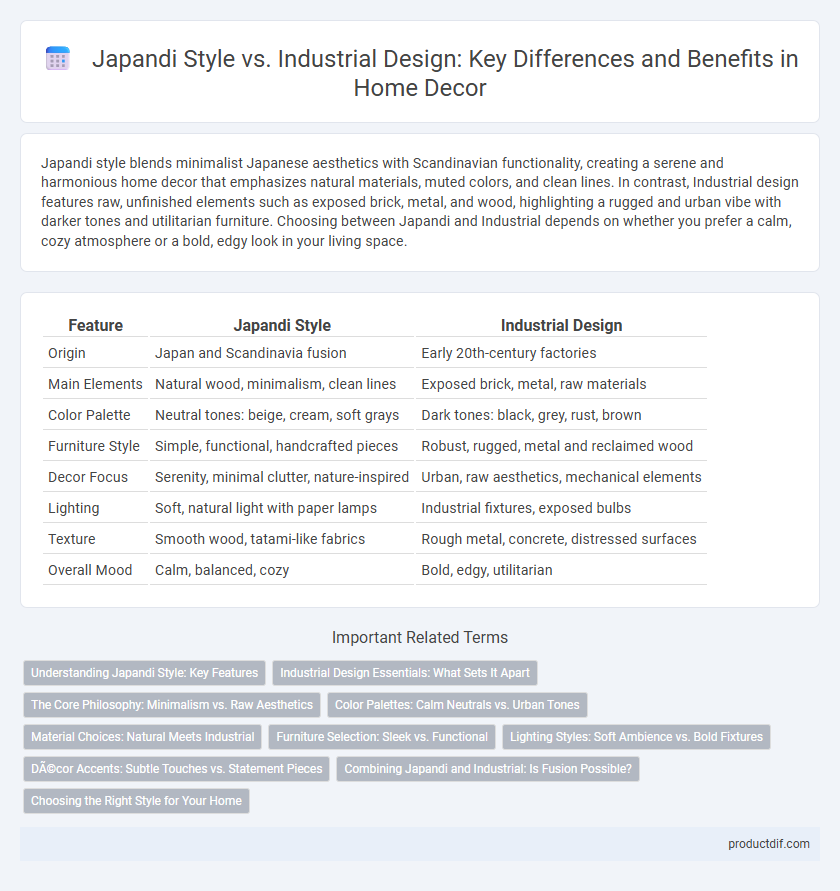Japandi style blends minimalist Japanese aesthetics with Scandinavian functionality, creating a serene and harmonious home decor that emphasizes natural materials, muted colors, and clean lines. In contrast, Industrial design features raw, unfinished elements such as exposed brick, metal, and wood, highlighting a rugged and urban vibe with darker tones and utilitarian furniture. Choosing between Japandi and Industrial depends on whether you prefer a calm, cozy atmosphere or a bold, edgy look in your living space.
Table of Comparison
| Feature | Japandi Style | Industrial Design |
|---|---|---|
| Origin | Japan and Scandinavia fusion | Early 20th-century factories |
| Main Elements | Natural wood, minimalism, clean lines | Exposed brick, metal, raw materials |
| Color Palette | Neutral tones: beige, cream, soft grays | Dark tones: black, grey, rust, brown |
| Furniture Style | Simple, functional, handcrafted pieces | Robust, rugged, metal and reclaimed wood |
| Decor Focus | Serenity, minimal clutter, nature-inspired | Urban, raw aesthetics, mechanical elements |
| Lighting | Soft, natural light with paper lamps | Industrial fixtures, exposed bulbs |
| Texture | Smooth wood, tatami-like fabrics | Rough metal, concrete, distressed surfaces |
| Overall Mood | Calm, balanced, cozy | Bold, edgy, utilitarian |
Understanding Japandi Style: Key Features
Japandi style blends Japanese minimalism with Scandinavian functionality, featuring natural materials like wood and bamboo, neutral color palettes, and clean lines that emphasize simplicity and calmness. Key features include uncluttered spaces, handcrafted elements, and a balance between form and function, promoting a serene and warm atmosphere. This style contrasts with Industrial design, which highlights raw textures, exposed metal, and a more rugged, utilitarian aesthetic.
Industrial Design Essentials: What Sets It Apart
Industrial design essentials center on raw materials such as exposed brick, metal fixtures, and reclaimed wood, creating an unfinished, utilitarian aesthetic. Functional elements like open ductwork, concrete floors, and vintage accents emphasize practicality and rugged charm. This style's distinct appeal lies in its blend of urban grit and minimalist structure, setting it apart from the softer, natural elements of Japandi design.
The Core Philosophy: Minimalism vs. Raw Aesthetics
Japandi style emphasizes minimalism through a harmonious blend of Japanese simplicity and Scandinavian functionality, prioritizing natural materials and muted color palettes to create serene, clutter-free spaces. Industrial design centers on raw aesthetics, showcasing exposed structural elements like metal, brick, and wood while embracing an unfinished, utilitarian look that highlights rugged textures. Both styles promote authenticity but differ fundamentally in their approach: Japandi seeks calm and balance, whereas Industrial revels in bold, unrefined character.
Color Palettes: Calm Neutrals vs. Urban Tones
Japandi style emphasizes calm neutrals such as soft beiges, warm whites, and muted grays, creating a soothing, minimalist atmosphere. Industrial design features urban tones like dark grays, blacks, and metallic finishes, evoking a raw, edgy aesthetic. Both palettes prioritize simplicity but differ in mood, with Japandi leaning towards tranquility and Industrial towards boldness.
Material Choices: Natural Meets Industrial
Japandi style emphasizes natural materials such as light woods, bamboo, and organic fabrics that create a warm, minimalist atmosphere. Industrial design incorporates raw, robust materials like exposed brick, steel, and reclaimed wood, delivering a rugged, urban aesthetic. Combining Japandi's soft textures with Industrial's sturdy elements results in a balanced fusion of nature-inspired warmth and industrial edge.
Furniture Selection: Sleek vs. Functional
Japandi style emphasizes sleek, minimalist furniture with natural wood tones and clean lines, creating a calm and harmonious environment. Industrial design favors functional, raw pieces often made from metal and reclaimed wood, highlighting utilitarian aesthetics and durability. Choosing furniture in Japandi style means prioritizing simplicity and subtle elegance, while Industrial design focuses on practicality and rugged charm.
Lighting Styles: Soft Ambience vs. Bold Fixtures
Japandi style embraces soft, diffused lighting that creates a warm and tranquil atmosphere through paper lanterns and natural fiber lampshades, enhancing minimalistic wood and neutral tones. Industrial design features bold, exposed fixtures such as metal pendant lights, Edison bulbs, and black iron sconces that contribute to a raw, edgy ambiance with a focus on functionality and urban aesthetics. Choosing between these lighting styles influences the home's overall mood, balancing subtle serenity in Japandi or striking visual impact in Industrial spaces.
Décor Accents: Subtle Touches vs. Statement Pieces
Japandi style emphasizes subtle decor accents such as minimalist ceramics, natural wood elements, and muted textiles that create a calming atmosphere. Industrial design features bold statement pieces like exposed metal fixtures, reclaimed wood furniture, and vintage Edison bulbs that add raw, urban character. Both styles prioritize functionality but differ in their approach to accentuating space through either understated elegance or striking industrial elements.
Combining Japandi and Industrial: Is Fusion Possible?
Fusion of Japandi and Industrial design styles is possible by blending Japandi's minimalistic warmth and natural materials with Industrial's raw textures and metal accents. Emphasizing functional furniture, neutral color palettes, and exposed structural elements creates a balanced, harmonious space. Incorporating soft textiles and organic shapes from Japandi alongside concrete, brick, and steel typical of Industrial design results in a unique, sophisticated home decor aesthetic.
Choosing the Right Style for Your Home
Japandi style combines minimalist Japanese aesthetics with Scandinavian functionality, emphasizing natural materials, muted colors, and simplicity, creating a calming and cozy environment. Industrial design features raw elements like exposed brick, metal fixtures, and reclaimed wood, offering an edgy, urban vibe that highlights structural integrity and open spaces. Choosing the right style depends on your preference for warmth and serenity with Japandi or bold, rugged charm through Industrial design, aligning with your home's architectural features and personal comfort.
Japandi style vs Industrial design Infographic

 productdif.com
productdif.com